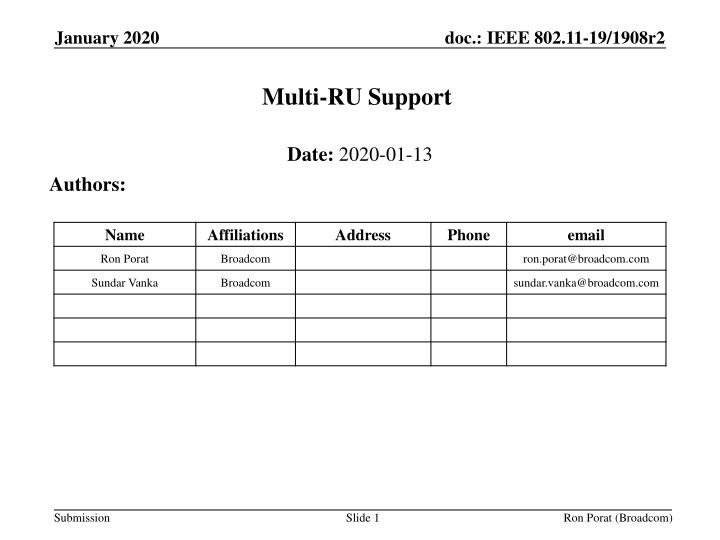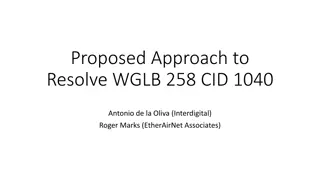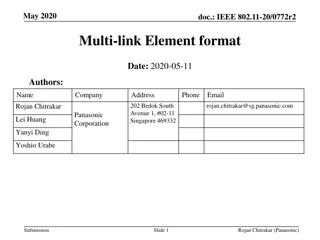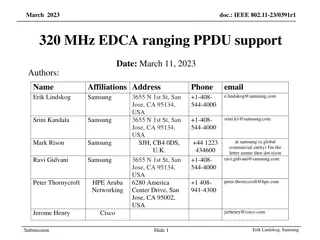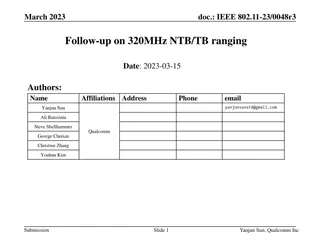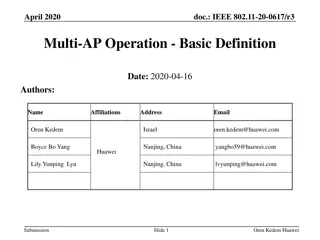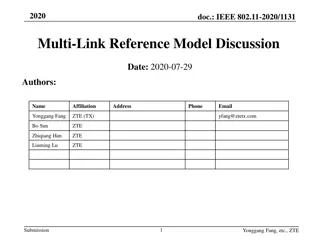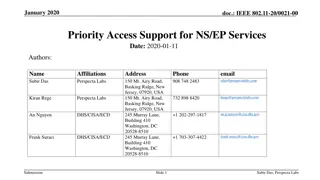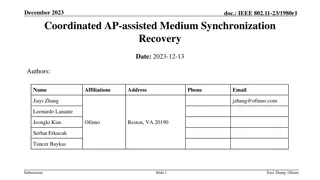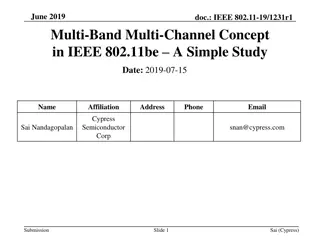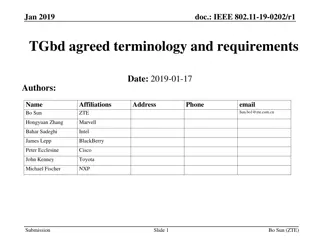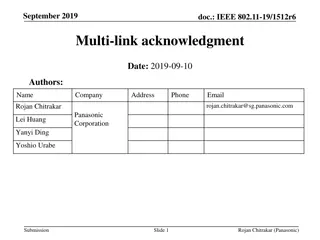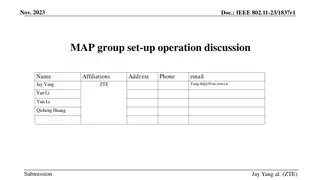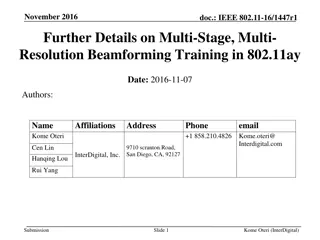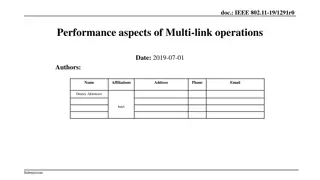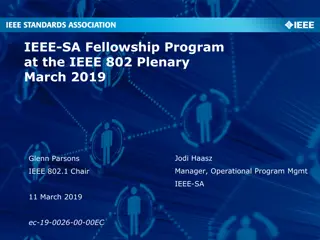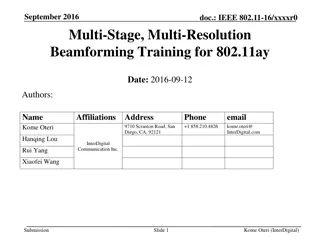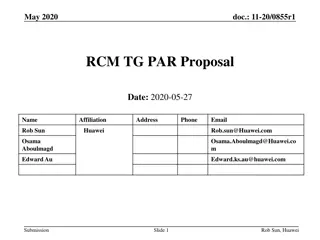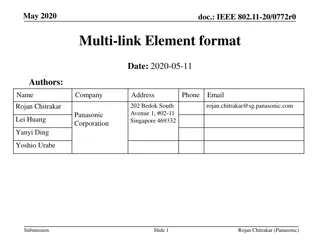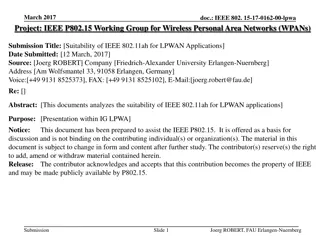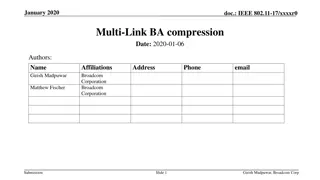IEEE 802.11-19/1908r2 Multi-RU Support Proposal
In January 2020, a proposal was made in the IEEE 802.11-19/1908r2 document regarding multi-RU support for STA, aiming to cover punctured BW modes and introducing new RU combinations. The proposal delves into design considerations, goals, and mandatory puncturing support for various channel sizes, particularly focusing on non-OFDMA settings. The document emphasizes minimizing RU combinations to essential cases and strategically supports different RU configurations for efficient spectrum utilization.
Download Presentation

Please find below an Image/Link to download the presentation.
The content on the website is provided AS IS for your information and personal use only. It may not be sold, licensed, or shared on other websites without obtaining consent from the author.If you encounter any issues during the download, it is possible that the publisher has removed the file from their server.
You are allowed to download the files provided on this website for personal or commercial use, subject to the condition that they are used lawfully. All files are the property of their respective owners.
The content on the website is provided AS IS for your information and personal use only. It may not be sold, licensed, or shared on other websites without obtaining consent from the author.
E N D
Presentation Transcript
January 2020 doc.: IEEE 802.11-19/1908r2 Multi-RU Support Date: 2020-01-13 Authors: Name Affiliations Address Phone email Ron Porat Broadcom ron.porat@broadcom.com Sundar Vanka Broadcom sundar.vanka@broadcom.com Submission Slide 1 Ron Porat (Broadcom)
January 2020 doc.: IEEE 802.11-19/1908r2 Abstract In the September meeting the group motioned that 11be shall allow more than one RU to be assigned to a single STA In this contribution we propose a set of RU combinations to be supported by STA This set of combinations should cover the allowed punctured BW modes supported by a single STA We focus here on BW<=160MHz. In r1 we add one more RU combination for non-OFDMA 160MHz (slide 7) Submission Slide 2 Ron Porat (Broadcom)
January 2020 doc.: IEEE 802.11-19/1908r2 Design Considerations and Goals We divide RU sizes into small {26,52,106} and large {242,484,996} and propose that no mixing of small and large RUs is supported as each 20MHz can either be assigned to one large user or be split among small users For non-OFDMA cases (SU or MU-MIMO across the BW) assume a minimum RU resolution of 20MHz due to current preamble BW and a desire to keep CCA on a 20MHz resolution For non-OFDMA cases punctured BW modes shall occupy at a minimum 50% of the non-punctured BW Support for RU combinations in OFDMA is preferably less than in non- OFDMA modes since the spectrum is now split among multiple STA. Submission Slide 3 Ron Porat (Broadcom)
January 2020 doc.: IEEE 802.11-19/1908r2 Cont. Minimize the RU combinations supported to only those that will be made mandatory (conditional on support for puncturing) Puncturing modes should support: 20MHz channels to accommodate Radars in 5GHz, 10MHz incumbent links in 6GHz and LBT failures on one or more 20MHz subbchannels 40MHz and 60 MHz channels to accommodate 30MHz incumbent links which are the most common incumbent BW in 6GHz Submission Slide 4 Ron Porat (Broadcom)
January 2020 doc.: IEEE 802.11-19/1908r2 Large RU combinations in non-OFDMA for BW<80MHz 484+242 supports contiguous 60MHz and non-contiguous 60MHz Puncturing one 20MHz anywhere in the 80MHz channel For 242+242 we only propose to support the case where both 242 RUs are the outer ones in the 80MHz (a [1001] configuration) since: Supporting the proposed configuration allows working around one 30MHz incumbent link in the middle of the 80MHz channel Supporting a [0110] configuration creates a 40MHz not aligned with the 40MHz channelization not a good idea Supporting a on-off [1010] configuration is difficult with 11ax [1212] SIG-B design RU size Agg. BW 40 MHz 242+242 60 MHz 484+242 Submission Slide 5 Ron Porat (Broadcom)
January 2020 doc.: IEEE 802.11-19/1908r2 Large RU combinations in OFDMA for BW<=80MHz Note that by OFDMA we mean a PPDU carrying information to at least two STA so the available BW can be split among them Compared to the previous slide, no need for 242+242 since that configuration can be split among 2 STA RU size Agg. BW 60 MHz 484+242 Submission Slide 6 Ron Porat (Broadcom)
January 2020 doc.: IEEE 802.11-19/1908r2 Large RU combinations in non-OFDMA for 80MHz<BW<160MHz Building on the 80MHz design we view the following configurations as important and sufficient: 100MHz covers cases where a 30MHz incumbent sits on three 20MHz subchannels 120MHz cover many cases for two 20MHz punctured subchannels or one 40MHz subchannel First configuration 30MHz incumbent occupies part of 40MHz on one side of one 80MHz Second configuration 30MHz incumbent occupies part of 40MHz in the middle of one 80MHz (242+242 is limited as described for 80MHz) Third configuration 30MHz incumbent occupies the middle of 160MHz (with 484+242 used as contiguous 60MHz on the outer sides). Many other cases of two punctured 20MHz subchannels are supported with all other configurations of 484+242 140MHz represents a likely case where just one 20MHz is punctured 80MHz RU size 484 484 242+242 484+242 484+242 80MHz RU size 484+242 996 996 484+242 996 Agg. BW 100 MHz 120 MHz 120 MHz 120 MHz 140 MHz Submission Slide 7 Ron Porat (Broadcom)
January 2020 doc.: IEEE 802.11-19/1908r2 Large RU combinations in OFDMA for 80MHz<BW<=160MHz Note again that by OFDMA we mean a PPDU carrying information to at least two STA so the available BW can be split among them 40 MHz and 80 MHz can already be achieved with one RU focus on adding support for the other aggregate BW values between 20 and 120 (484+242) = means combination allowed only within 80MHz RU size Agg. BW 60 MHz 100 MHz 120 MHz (484+242) 484+(484+242) 484+996 Submission Slide 8 Ron Porat (Broadcom)
January 2020 doc.: IEEE 802.11-19/1908r2 Small RU {26,52,106} Combinations in OFDMA Prefer to only add support for contiguous 26+52 and 26+106 within a 20MHz. These modes enable better usage of a 20MHz by allowing 2 users to share it even if an edge 26RU is punctured out For full 20MHz use 106+26 for one user and 106 for another efficient support for 8 users in 80MHz or 16 users in 160MHz For punctured edge 26RU (if that 20MHz is split among small users) use 106+26 for one user and 52+26 for another We don t see the need to support non-contiguous small RU combinations since typical MIMO configurations of AP and STA already provide sufficient diversity and CQI feedback may be used to choose good locations for small RU. Submission Slide 9 Ron Porat (Broadcom)
January 2020 doc.: IEEE 802.11-19/1908r2 Summary Proposed a conditional mandatory list of supported large RU combinations for BW up to 320MHz Proposed a list for small RU combinations within 20MHz Proposed not to mix small and large RU Submission Slide 10 Ron Porat (Broadcom)
January 2020 doc.: IEEE 802.11-19/1908r2 Straw Poll 1 Do you support the conditional mandatory (conditional on supporting puncturing) large RU combinations for 80MHz non-OFDMA as described below: 484+242 supports contiguous 60MHz and non-contiguous 60MHz Puncturing one 20MHz anywhere in the 80MHz channel For 242+242 we only support the case where both 242 RUs are the outer ones in the 80MHz (a [1001] configuration) Note: several tones at the edge may be punctured RU size Agg. BW 40 MHz 242+242 60 MHz 484+242 Submission Slide 11 Ron Porat (Broadcom)
January 2020 doc.: IEEE 802.11-19/1908r2 Straw Poll 2 Do you support the large RU combinations for 80MHz OFDMA as described below? RU size Agg. BW 60 MHz 484+242 Y N A Submission Slide 12 Ron Porat (Broadcom)
January 2020 doc.: IEEE 802.11-19/1908r2 Straw Poll 3 Do you support the large RU combinations for 160MHz non-OFDMA as described as described below? CM conditional mandatory on supporting puncturing O- optional 80MHz RU size 484 484+242 484+242 80MHz RU size 996 484+242 996 Agg. BW Notes 120 MHz 120 MHz 140 MHz CM O CM Submission Slide 13 Ron Porat (Broadcom)
January 2020 doc.: IEEE 802.11-19/1908r2 Straw Poll 4 Do you support the large RU combinations for 160MHz OFDMA as described in slide 8? () means within 80MHz RU size Agg. BW 60 MHz 100 MHz 120 MHz (484+242) 484+(484+242) 484+996 Y N A Submission Slide 14 Ron Porat (Broadcom)
January 2020 doc.: IEEE 802.11-19/1908r2 Straw Poll 5 Do you support the small RU combinations of 26+52 and 26+106? Y N A Submission Slide 15 Ron Porat (Broadcom)
